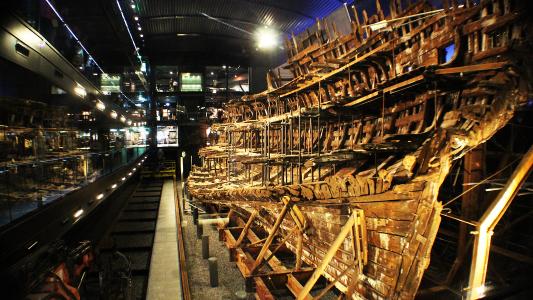The Great Pyramid in Egypt is the last of the ancient Seven Wonders of the World. The tomb for Pharaoh Khufu — “Cheops” in Greek — sits on the Giza plateau about 3 kilometers southwest of Egypt’s capitol Cairo, and it’s huge: nearly 147 meters high and 230.4 meters on each side (it’s now slightly smaller due to erosion). Built of roughly 2.3 million limestone and rose granite stones from hundreds of kilometers away, it’s long posed a couple of vexing and fascinating mysteries: How did the ancient Egyptians manage to get all of these stones to Giza, and how did they build such a monumental object? All sorts of exotic ideas have been floated, including assistance from aliens visiting earth. Now, as the result of an amazing find in a cave 606 kilometers away, we have an answer in the form of 4,600-year-old, bound papyrus scrolls, the oldest papyri ever found. They’re the journal of one of the managers who helped build the great pyramid. It’s the only eye-witness account of building the Great Pyramid that’s ever been found.
It was written by a man named Merer, who reported to “the noble Ankh-haf,” Khufu’s half-brother. It describes, among other things, a stop of his 200-man crew in the Tura, or Maasara, limestone quarries on the eastern shore of the Gulf of Suez, and filling up their boat for the 13-17 km trip back up the river to Giza. Since this type of limestone was used for the pyramid’s outer casing, the journal is believed to document work on the tomb during the final year of Khufu’s life, around 2560 BCE.
In 1823, British explorer John Gardner Wilkinson first described the caves in Wadi al-Jarf on the eastern coast of the Red Sea: “Near the ruins is a small knoll containing eighteen excavated chambers, beside, perhaps, many others, the entrance of which are no longer visible.” He described them as being “well cut and vary from about 80 to 24 feet, by 5; their height may be from 6 to 8 feet.” Two French pilots also noted presence of the 30 caves in the mid-1950s, but it wasn’t until Pierre Tallet interviewed one of the pilots that he was able to pinpoint the caves’ location during a 2011 dig. Two years later, the papyri were discovered. Egyptian archaeologist Zahi Hawass called it “the greatest discovery in Egypt in the 21st century.”
Prior to the work of Tallet and others, the ancient Egyptians weren’t thought to be seafarers, but abandoned ports unearthed along the Gulf of Suez and the Red Sea tell a different story.
In the Egyptian resort town Ayn Soukhna, along the west coast of the Suez, Egyptian heirogplyhs were first found on cliff walls in 1997. “I love rock inscriptions,” Tallet told Smithsonian, “they give you a page of history without excavating.” He read one to the Smithsonian: “In year one of the king, they sent a troop of 3,000 men to fetch copper, turquoise and all the good products of the desert.”
That would be the Sinai desert across the Red Sea, and Wadi al-Jarf is only 56 km away from two of a group of ports. Tallet has uncovered the remains of an 182-meter, L-shaped jetty there, along with 130 anchors. He believes it, like Ayn Soukhna, were part of a series of ports, supply hubs, bringing needed materials into Egypt. The caves were apparently built for boat storage, as they have been elsewhere around the edges of ancient Egypt. It appears Wadi al-Jarf was only in use a short while, during the building of the pyramid — it likely supplied the project with Sinai copper, the hardest metal of its time, for cutting stones.
The second part of the Great Pyramid mystery — who built it? — may have been solved in the 1980s by Mark Lehner, who uncovered a residential area capable of housing some 20,000 people just meters from the pyramids. Prior to that find, there was scant evidence of the massive population of workers that would have been required for building the tomb. Studying the “cattle-to-pig” ratio revealed the diversity of the population that lived there,: Beef was the food of the elite; pigs of the working person, and Lerhner discovered “the ratio of cattle to pig for the entire site stands at 6:1, and for certain areas 16:1,” a plausible distribution for the construction team.
Lehner visited Wadi al-Jarf and concurs with Tallet about its meaning: “The power and purity of the site is so Khufu,” he told Smithsonian. “The scale and ambition and sophistication of it — the size of these galleries cut out of rock like the Amtrak train garages, these huge hammers made out of hard black diorite they found, the scale of the harbor, the clear and orderly writing of the hieroglyphs of the papyri, which are like Excel spreadsheets of the ancient world—all of it has the clarity, power and sophistication of the pyramids, all the characteristics of Khufu and the early fourth dynasty.” He believes the pyramid stones were transported by boat from ports like Wadi al-Jarf and Ayn Soukhna via canals to the construction site in Giza, the ancient Egyptians having been master builders of such waterways for the purposes of irrigation.
We’d love to hear from you! If you have a comment about this article or if you have a tip for a future Freethink story, please email us at [email protected].






